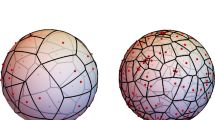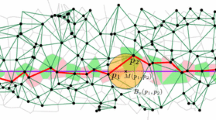Abstract
Consider the distances \(\tilde{R}_o\) and \(R_o\) from the nucleus to a uniformly random point in the 0-cell and the typical cell, respectively, of the d-dimensional Poisson–Voronoi (PV) tessellation. The main objective of this paper is to characterize the exact distributions of \(\tilde{R}_o\) and \(R_o\). First, using the well-known relationship between the 0-cell and the typical cell, we show that the random variable \(\tilde{R}_o\) is equivalent in distribution to the contact distance of the Poisson point process. Next, we derive a multi-integral expression for the exact distribution of \(R_o\). Further, we derive a closed-form approximate expression for the distribution of \(R_o\), which is the contact distribution with a mean corrected by a factor equal to the ratio of the mean volumes of the 0-cell and the typical cell. An additional outcome of our analysis is a direct proof of the well-known spherical property of the PV cells having a large inball.







Similar content being viewed by others
Notes
The simultaneously growing sets of randomly distributed nuclei (realized through PPP) at equal isotropic rate are referred to as the PV transformation. These sets eventually transform into the PV cells.
The surface area in this case is the Lebesgue measure in \(d-1\) dimensions.
References
Møller, J.: Random tessellations in \(\mathbb{R}^d\). Adv. Appl. Probab. 21(1), 37–73 (1989)
Muche, L., Stoyan, D.: Contact and chord length distributions of the Poisson Voronoi tessellation. J. Appl. Probab. 29(2), 467–471 (1992)
Calka, P.: The distributions of the smallest disks containing the Poisson-Voronoi typical cell and the Crofton cell in the plane. Adv. Appl. Probab. 34(4), 702–717 (2002)
Calka, P.: An explicit expression for the distribution of the number of sides of the typical Poisson-Voronoi cell. Adv. Appl. Probab. 35(4), 863–870 (2003)
Hug, D., Reitzner, M., Schneider, R.: Large Poisson–Voronoi cells and Crofton cells. Adv. Appl. Probab. 36(3), 667–690 (2004)
Kumar, S., Kurtz, S.K., Banavar, J.R., Sharma, M.: Properties of a three-dimensional Poisson–Voronoi tesselation: A Monte Carlo study. J. Stat. Phys. 67(3–4), 523–551 (1992)
Mecke, J.: On the relationship between the 0-cell and the typical cell of a stationary random tessellation. Pattern Recogn. 32(9), 1645–1648 (1999)
Koufos, K., Dettmann, C.P.: Distribution of cell area in bounded Poisson Voronoi tessellations with application to secure local connectivity. J. Stat. Phys. 176, 1296–1315 (2019)
Jahnel, B., Tóbiás, A.: Exponential moments for planar tessellations. J. Stat. Phys. 179, 1–20 (2020)
Pineda, E., Crespo, D.: Temporal evolution of the domain structure in a Poisson–Voronoi transformation. J. Stat. Mech. 2007(06), P06007 (2007)
Baccelli, F., Blaszczyszyn, B.: Stochastic geometry and wireless networks: volume I theory. In: Foundations and Trends in Networking (2009)
Andrews, J.G., Baccelli, F., Ganti, R.K.: A tractable approach to coverage and rate in cellular networks. IEEE Trans. Commun. 59(11), 3122–3134 (2011)
Dhillon, H.S., Ganti, R.K., Baccelli, F., Andrews, J.G.: Modeling and analysis of K-tier downlink heterogeneous cellular networks. IEEE J. Select. Areas Commun. 30(3), 550–560 (2012)
Haenggi, M.: Stochastic Geometry for Wireless Networks. Cambridge University Press, Cambridge (2013)
Blaszczyszyn, B., Haenggi, M., Keeler, P., Mukherjee, S.: Stochastic Geometry Analysis of Cellular Networks. Cambridge University Press, Cambridge (2018)
Haenggi, M.: User point processes in cellular networks. IEEE Wirel. Commun. Lett. 6(2), 258–261 (2017)
Mankar, P.D., Parida, P., Dhillon, H.S., Haenggi, M.: Downlink analysis for the typical cell in Poisson cellular networks. IEEE Wirel. Commun. Lett. 9(3), 336–339 (2020)
Møller, J.: Lectures on Random Voronoi Tessellations. Springer, New York (2012)
Alishahi, K., Sharifitabar, M.: Volume degeneracy of the typical cell and the chord length distribution for Poisson-Voronoi tessellations in high dimensions. Adv. Appl. Probab. 40(4), 919–938, 12 (2008)
Robbins, H.E.: On the measure of a random set. Ann. Math. Stat. 15(1), 70–74 (1944)
Pineda, E., Crespo, D.: Temporal evolution of the domain structure in a Poisson-Voronoi nucleation and growth transformation: Results for one and three dimensions. Phys. Rev. E 78(2), 021110 (2008)
Wang, Y., Haenggi, M., Tan, Z.: The meta distribution of the SIR for cellular networks with power control. IEEE Trans. Commun. 66(4), 1745–1757 (2018)
Olsbo, V.: On the correlation between the volumes of the typical Poisson Voronoi cell and the typical Stienen sphere. Adv. Appl. Probab. 39(4), 883–892 (2007)
Li, S.: Concise formulas for the area and volume of a hyperspherical cap. Asian J. Math. Stat. 4(1), 66–70 (2011)
Calka, P., Schreiber, T.: Limit theorems for the typical Poisson–Voronoi cell and the Crofton cell with a large inradius. Ann. Probab. 33(4), 1625–1642 (2005)
Miles, R.E.: A heuristic proof of a long-standing conjecture of D. G. Kendall concerning the shapes of certain large random polygons. Adv. Appl. Probab. 27(2), 397–417 (1995)
Acknowledgements
This work was supported by the United States National Science Foundation under Grant ECCS-1731711.
Author information
Authors and Affiliations
Corresponding author
Additional information
Communicated by Eric A. Carlen.
Publisher's Note
Springer Nature remains neutral with regard to jurisdictional claims in published maps and institutional affiliations.
This work was performed when P. Mankar was with Wireless@VT, Bradley Department of Electrical and Computer Engineering, Virginia Tech, Blacksburg, VA, USA.
Solution of Integral in (41)
Solution of Integral in (41)
Let \(a=\frac{d-1}{2}\) and \(b=\frac{1}{2}\). From step (a) of (41) and using \(I_x(a,b)=\frac{B_x(a,b)}{B(a,b)}\), we have
where \(\nu _R=\frac{{d((R+\epsilon )^d-R^d)^{-1}}}{2B\left( a,b\right) }\). We solve the above integral using integration by parts as follows. Let \(v=l^{d-1}\) and \(u=B_{1-\frac{l^2}{(R+\epsilon )^2}}\left( \frac{d-1}{2},\frac{1}{2}\right) \). We have
and thus
Now, substituting \(\frac{l^2}{(R+\epsilon )^2}=z\), we get
where \(\tilde{\nu }_R=\frac{1}{2((R+\epsilon )^d-R^d)}\). Step (a) follows using \(I_{x}(a,b)=1-I_{1-x}(b,a)\) and \(B(a,b)=B(b,a)\).
Rights and permissions
About this article
Cite this article
Mankar, P.D., Parida, P., Dhillon, H.S. et al. Distance from the Nucleus to a Uniformly Random Point in the 0-Cell and the Typical Cell of the Poisson–Voronoi Tessellation. J Stat Phys 181, 1678–1698 (2020). https://doi.org/10.1007/s10955-020-02641-w
Received:
Accepted:
Published:
Issue Date:
DOI: https://doi.org/10.1007/s10955-020-02641-w




